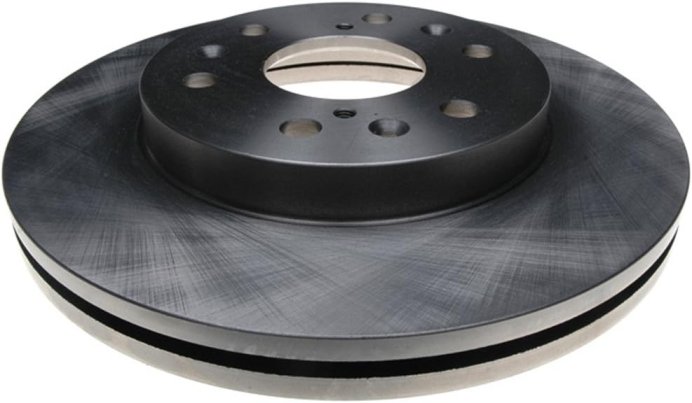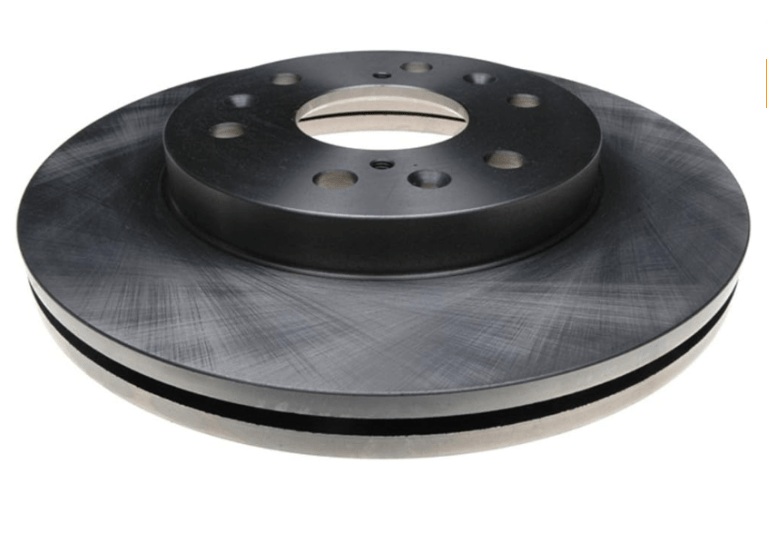We may earn revenue from the products available on this page and participate in affiliate programs. Learn more ›

Brake rotors need replacing every so often. There’s no way around it. They’re a wear item, they’re crucial to your safety, and the right set can make a big difference in the vehicle’s performance. Nine times out of 10, you’re going to hit the parts store and buy whatever you can walk away with that day, which is usually good enough to get by. Even so, it helps to know as much as possible about what makes the best brake rotor. Especially if you’re looking to improve performance for one reason or another. I might not know exactly what your goals are, but I do know a thing or two about brake rotors and I’m happy to help point you in the right direction.
Summary List
- Best Overall: Raybestos R-Line Brake Rotor
- Best Value: ACDelco Silver Brake Rotor
- Honorable Mention: EBC Brakes Dimpled and Slotted Sport Rotor
- Best for Comfort: Bosch QuietCast Premium Disc Brake Rotor
- Best Performance Bundle: Power Stop Z26 Carbon Fiber Brake Pads with Drilled and Slotted Brake Rotors Kit
Our Methodology
Brake rotors are straightforward. In most cases, you will be fine going to the local parts store and ordering whatever the counter person looks up for your application. I’ve done just that countless times and never ran into any issues. That doesn’t mean you won’t take to the internet to find something for yourself, and I’m here to help. Below are the brands I’ve grown to trust over the years. I either have hands-on experience with them or know those who have. I’ve also done significant research to make sure only those we trust made the list. After all, the room for error with brake rotors is nonexistent.
Best Brake Rotors: Reviews & Recommendations
Best Overall: Raybestos R-Line Brake Rotor
Pros
- Great pricing for most applications
- Reduced noise and vibration
- High quality replacement part
Cons
- No performance benefit over factory
If you drive it on the streets on a daily basis, Raybestos R-Line rotors are the way to go. They’re designed for that exact type of driving. Reduced vibration and lower noise levels than many alternatives, along with the use of quality materials, ensure these rotors are as attractive as they are affordable. Seeing as these rotors are available for most applications, it’s almost impossible not to recommend them.
I can technically dock points by factoring in the lack of performance features this option brings to the table. Also, as Raybestos’ economy option, it’s worth pointing out that it’s only slightly more affordable than the premium option for some applications, making it easy to skip past.
Best Value: ACDelco Silver Brake Rotor
Pros
- Matches factory level of quality and performance
- Premium finish
- Affordable pricing
- 12-month warranty
Cons
- No performance gains
- More limited applications than some competitors
Those of you with a General Motors vehicle can save money and still get quality rotors with ACDelco’s Silver line. These rotors offer the airflow, performance, and low road noise you’d expect from the factory only without going broke. That’s because ACDelco is the manufacturer for GM vehicles, meaning you’re also getting the best fit and finish possible. As if that’s not enough, this rotor is also backed with a 12-month unlimited-mile warranty.
This line is not a performance upgrade. It is also only available to a limited number of vehicles, and few vehicle owners can take advantage of the line.
Honorable Mention: EBC Brakes Dimpled and Slotted Sport Rotor
Pros
- Dimpling gives gas venting benefit of drilled
- Since the holes aren’t all the way through, they won’t cause cracking
- Slots in rotor scrape pads to reduce glazing
- Improved performance over factory
Cons
- Depending on application, may be more expensive than factory
- Noisier than factory rotors
- May decrease pad life
Swapping in some EBC rotors is one of the first things many vehicle owners will do. There are performance gains to be had, but it’s hard to deny the aesthetic appeal of these sporty, black rotors. As for what really matters, these are slotted and dimpled rotors that use wider slots to keep the brakes cooler while dimpling instead of drilling avoids cracks. These have the added benefit of reducing brake fade under load and heavy braking. Promoting even pad wear and consistent braking throughout the life of the pads are just more ways this design sweetens the pot.
The price is a major downside for these rotors, considering the minimal gains they offer for average drivers. And though the design implements some features to cut down on noise, it doesn’t change the fact that these rotors generate more noise than smooth rotors.
Febbo has used EBC rotors and pads on multiple project builds. They are his normal go-to brand for everything from fast road to track cars; when he wants to stick to a reasonable budget. It’s hard to go wrong with these and EBC offers a wide variety of pads to match your needs.
Best for Comfort: Bosch QuietCast Premium Disc Brake Rotor
Pros
- Superior sound attenuation
- Precision balanced
- Corrosion resistant coating
- Huge list of applications
Cons
- More expensive than your average part store rotor
Bosch Quietcast is a good name for rotors for the daily commuter. As the name implies, these rotors offer superior noise damping to make the ride as enjoyable as possible. These are built with precision balancing, original-equipment vane configuration, and coated with a durable aluminum zinc plating to keep corrosion at bay. In almost all ways, it’s a step up from any factory rotors and is available to any of today’s passenger vehicles, both foreign and domestic.
The primary drawback to this rotor is that it’s more expensive than many other options. This is also not a performance upgrade, even if it’s costlier than other options.
Best Performance Bundle: Power Stop Z26 Carbon Fiber Brake Pads with Drilled and Slotted Brake Rotors Kit
Pros
- Kit covers both axles
- Improves braking performance and fade resistance
- Low dust for a carbon fiber pad
Cons
- Drilled holes may promote rotor cracking
- Limited applications
If you’re looking for an all-in-one bundle to simplify upgrading your car, Power Stop’s Z26 pad and rotor kit has your name all over it. The set includes front and rear drilled and slotted rotors that keep the brakes cool under hard driving and offers maximum consistency of pad performance. The kit includes carbon-fiber ceramic pads to further boost high-speed braking performance while keeping dust low. As far as performance pad and rotors go, this is also one of the most affordable options.
While Power Stop does offer performance kits for a wide range of applications, including trucks, the Z26 package is available to a limited number of vehicles. You also need to be aware that drilled holes do compromise structural integrity of the rotors.
Our Verdict on the Best Brake Rotors
The Raybestos R-Line Brake Rotor is almost impossible to beat, at least when it comes to OE-type applications. It’s affordable, built well, and widely available. But if the ACDelco Silver Brake Rotor is an option for you, you can save money by choosing it instead.
FAQs
You’ve got questions. The Drive has answers.
A: Yes. Brake rotors can be reused as long as there’s no serious wear or damage. Even then, they can often be taken in for resurfacing at the local machine shop.
A: Smooth rotors: Smooth rotors are the most common type as it’s what most original equipment manufacturers, or OEMs, use on their vehicles. There are also plenty of aftermarket brake conversion kits that rely on this type of rotor. Smooth rotors have the advantages of long pad life, low noise, and ample stopping power under normal conditions. They are not the premier choice for performance applications, but modern advancements do narrow the gap between smooth and other rotor designs. It’s also important to remember that pads and tires are far more important to brake performance than the rotor alone.
Drilled rotors: Drilled rotors have a series of holes drilled through them. These holes let gasses created by the pads escape to keep performance consistent in heavy braking situations. There are three drawbacks to this design. One is the reduction of the rotor’s structural integrity. The presence of holes also increases pad wear and drives up the selling price. That might be a fair tradeoff if the holes did more for the driver. Today’s pads don’t have much of an issue with off-gassing, and many manufacturers feature them in rotors because of their aesthetic appeal.
Slotted rotors: Slotted rotors feature grooves that run along the surface of the rotor. This design helps to deal with the glaze left on overheated pads and improves braking consistency. Of course, the presence of slots reduces the rotor’s structural integrity, but to a minimal degree. The other tradeoff is reduced pad life, which is thanks to the intentional removal of a small layer of the pads as slots pass by them to remove glazing. Even so, slotted rotors are far more practical in today’s day and age than drilled rotors and are the choice for vehicles that see actual track time or any other kind of hard driving.
Drilled and slotted: This type of rotor combines the features of the previous two types discussed, making for a design with the advantages of both. The presence of holes and slots does lower the structural integrity of the rotor, and manufacturing becomes more complicated, which drives the cost up. These do wear through pads much more quickly than the other types of rotors, further driving up the expense of ownership.
A: Cracks, grooves, and warping are several things to look for. If you can spot any of these, it’s time to either replace or resurface the rotors. A grinding sound while driving is also often a sign that rotors need repair or replacement.
A: Under normal driving, brake rotors should last 50,000 to 70,000 miles. Because you’re bound to brake hard, ride the brakes, and encounter all kinds of things that fall outside of normal driving circumstances, your mileage will vary.
A: Fixing warped rotors might be an option if the damage is minimal, but it depends on the situation. A machine shop that can resurface the rotors must be consulted to determine what’s possible for your given situation.
A: It’s usually more economical to replace a factory rotor. However, resurfacing is a great option for high-end applications that rely on expensive specialty rotors that can’t easily be sourced.
A: It’s difficult to put a set price on brake rotors. The make, model, and position of the rotors on the vehicle largely determine what you’re going to pay, but stock-type rotors don’t usually cost more than $50-$100 apiece. Moving to aftermarket specialty rotors can double or triple the price, depending on the manufacturer and specialty features included.








